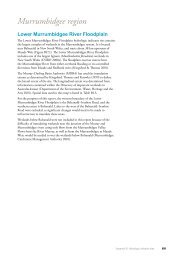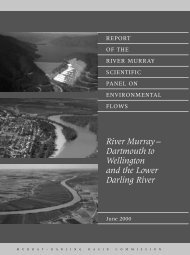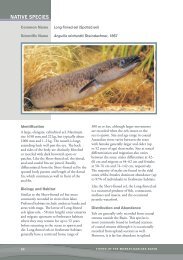Inland shipping navigation murraydarling river system
Inland shipping navigation murraydarling river system
Inland shipping navigation murraydarling river system
Create successful ePaper yourself
Turn your PDF publications into a flip-book with our unique Google optimized e-Paper software.
4<br />
Impacts of Steamers<br />
Riverboats and their barges could carry heavy, bulky<br />
and also relatively fragile cargos, which could not<br />
physically or economically be carried great<br />
distances by bullock wagon. A paddle steamer<br />
and barges could carry up to 2 000 bales of<br />
wool, which today would require twenty<br />
semi-trailer trucks to transport. Machinery<br />
(such as steam engines and gold mining<br />
equipment), wire, roofing iron, general<br />
supplies and luxuries (such as window glass<br />
and pianos) could be transported far inland<br />
by <strong>river</strong> and then distributed to the<br />
surrounding areas by bullock, camel or horse<br />
team. Paddle steamers greatly improved the<br />
standard of living and reduced the sense of<br />
isolation, especially in the western and<br />
southern parts of the Basin.<br />
During the paddle steamer era, children in the<br />
towns and on the stations along the <strong>river</strong>s knew<br />
the different paddle steamers and their captains and<br />
crews.They had their favourite boats and learned all<br />
they could about them.They could recognise<br />
different boats by the sounds of their<br />
whistles and engines.The sound of<br />
a boat always caused great<br />
excitement.<br />
Australia’s Great<br />
Waterway<br />
(by G.G. in the “AGE”)<br />
… The leviathans of the Murray get up steam<br />
by the use of wood. ‘Wood piles’ dot the bank<br />
of the <strong>river</strong> at stages of 25 and 50 miles,<br />
sometimes less. Each of these ‘piles’ is<br />
replenished for the benefit of the steamboats<br />
by two, three or four wood-getters who often<br />
live in the wilderness, and get in touch with the<br />
great world to a very limited degree only when<br />
a boat passes on its upward or downward<br />
journey.<br />
Occasionally a woman is to be seen in one of<br />
these far-back isolated wood camps, and<br />
sometimes half a dozen little urchins almost as<br />
fleet and as wild as the rabbits that swarm in<br />
the bush around them. When the steamer is<br />
hauled alongside for ‘wooding’ the passenger<br />
views a primitive method of loading. A plank is<br />
placed as a gangway to the bank, and along this<br />
three or four men will take their stand. The<br />
man ashore grips a log, and it is passed from<br />
hand to hand until it is stacked near the stoke<br />
hole. When two or three or four tonnes have<br />
been shifted, the ropes are ‘untied’ and the little<br />
vessel steams away. From three quarters of a<br />
ton to a ton of wood are burnt aboard every<br />
hour, and in most cases it is reckoned that a ton<br />
will take the boat about ten miles…<br />
Captains<br />
Steamer captains on the Murray-Darling<br />
<strong>system</strong> were a mixed group who came<br />
from many parts of the world. Some<br />
were deep-sea sailors like Francis<br />
Cadell, while others, like William<br />
Randell, had no previous sailing<br />
experience. In addition to Australianborn<br />
captains, there were a number<br />
of Scots who originally worked for<br />
Francis Cadell, including George<br />
Johnston,William Barber and James<br />
Ritchie.The only ethnic Chinese captain,<br />
John Egge, also originally worked for Cadell.<br />
There were many captains who originally came from<br />
Scandinavian countries including Johann Arnold,<br />
Gustaf Lindquist and Charles Wollin.There was a<br />
Negro skipper, Daniel Alexander, and a number of<br />
other Americans.<br />
Names<br />
Murray-Darling steamers had a great variety of<br />
names. Some were named after large sheep stations<br />
along the <strong>river</strong>s, such as the ‘Canally’ and the<br />
‘Pevensey’ and the ‘Nangus’. Others were named for<br />
the town that they hoped to reach.The first two<br />
steamers on the River Murray were named in honour<br />
of people.The ‘Mary Ann’ was named after Captain<br />
William Randell’s mother To obtain political support,<br />
Captain Cadell named the ‘Lady Augusta’ in honour of<br />
the wife of Sir Henry Fox Young, the Governor of<br />
South Australia at the time. Other steamers with<br />
women’s names included the ‘Marion’, the ‘Emily Jane’<br />
and the ‘Ellen’. Perhaps the oddest, but most<br />
appropriate name was the ‘Nil Desperandum’<br />
which roughly translated from Latin<br />
means ‘do not despair’ or ‘no<br />
worries’.<br />
Typical Steamer Cargo<br />
Echuca-River Season 1908<br />
Francis Cadell<br />
Outward Approximate Inward Approximate<br />
percentage percentage of<br />
of total total<br />
Station Supplies:- Wool (include skins & tallow) 53<br />
(woolpacks, soap, cornsacks, Wheat 29<br />
beer, galvanised iron, Sleepers 8<br />
kerosene) 24 Sawn timber 3<br />
Store goods:- Salt 2<br />
(Drapery, spirits, hardware, Other goods 5<br />
furniture, small goods) 18<br />
Sugar 14<br />
Manures 14<br />
Timber 9<br />
Flour 8<br />
Wire<br />
Agricultural produce:<br />
7<br />
(oats, chaff, potatoes, onions) 6<br />
100 100





